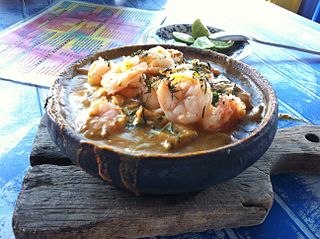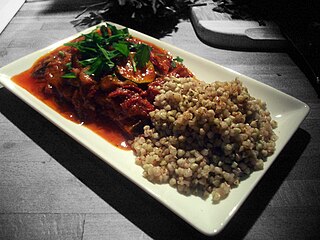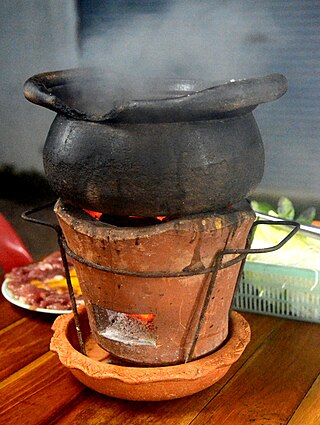
Minestrone is a thick soup of Italian origin made with meats, vegetables, and pasta. Ingredients include beans, onions, celery, carrots, leaf vegetables, stock, Parmesan cheese and tomatoes.

Goulash is a soup or stew of meat and vegetables seasoned with paprika and other spices. Originating in Hungary, goulash is a common meal predominantly eaten in Central Europe but also in other parts of Europe. It is one of the national dishes of Hungary and a symbol of the country.

Gumbo is a stew that is popular in the U.S. state of Louisiana, and is the official state cuisine. Gumbo consists primarily of a strongly flavored stock, meat or shellfish, a thickener, and the Creole "holy trinity" – celery, bell peppers, and onions. Gumbo is often categorized by the type of thickener used, whether okra or filé powder.

Jambalaya is a savory rice dish of mixed origins that developed in the U.S. state of Louisiana apparently with African, Spanish, and French influences, consisting mainly of meat or seafood, and vegetables mixed with rice and spices.

Pilaf, pilav or pilau is a rice dish, usually sautéed, or in some regions, a wheat dish, whose recipe usually involves cooking in stock or broth, adding spices, and other ingredients such as vegetables or meat, and employing some technique for achieving cooked grains that do not adhere to each other.

A casserole is a kind of large, deep pan or bowl used for cooking a variety of dishes in the oven; it is also a category of foods cooked in such a vessel. To distinguish the two uses, the pan can be called a "casserole dish" or "casserole pan", whereas the food is simply "a casserole". The same pan is often used both for cooking and for serving.

Bouillabaisse is a traditional Provençal fish soup originating in the port city of Marseille. The word is originally a compound of the two Provençal verbs bolhir and abaissar.

A tajine or tagine is a North African dish, named after the earthenware pot in which it is cooked. It is also called maraq or marqa.

Peasant foods are dishes eaten by peasants, made from accessible and inexpensive ingredients.

Clay pot cooking is a process of cooking food in a pot made of unglazed or glazed pottery.

Daube is a French slow-cooked stew, usually of beef, but other meat is sometimes used. The best-known is the bœuf en daube à la provençale, a provençal stew made with cheaper cuts of beef braised in wine, with vegetables, garlic and herbs, and traditionally cooked in a daubière – a braising pot.

Cazuela is the common name given to a variety of dishes, especially from South America. It receives its name from the cazuela – traditionally, an often shallow pot made of unglazed earthenware used for cooking. The ingredients and preparation vary from region to region, but it is usually a mid-thick flavoured stock obtained from cooking several kinds of meats and vegetables mixed together.

Ratatouille is a French Provençal dish of stewed vegetables that originated in Nice and is sometimes referred to as ratatouille niçoise. Recipes and cooking times differ widely, but common ingredients include tomato, garlic, onion, courgette (zucchini), aubergine, capsicum, and some combination of leafy green herbs common to the region, such as chives or fennel.

Soup is a primarily liquid food, generally served warm or hot, that is made by combining ingredients of meat or vegetables with stock, milk, or water. Hot soups are additionally characterized by boiling solid ingredients in liquids in a pot until the flavors are extracted, forming a broth. Soups are similar to stews, and in some cases there may not be a clear distinction between the two; however, soups generally have more liquid (broth) than stews.

Tiella is an Italian dish prepared with potato, rice, onion and mussels as primary ingredients; additional ingredients may be used. Variations of the dish exist, some of which may be prepared with other types of seafood. Tiella is part of Apulian cuisine. It may also be found in coastal areas of the Calabria region. The round earthenware dish in which tiella is traditionally cooked is also referred to as tiella.

Chim chum is a Southeast Asian street food, popular especially in Thailand. It is traditionally made with chicken or pork and fresh herbs such as galangal, sweet basil, lemongrass and kaffir lime leaves, cooked in a small clay pot on a charcoal stove. It is often served with nam chim.

A stew is a combination of solid food ingredients that have been cooked in liquid and served in the resultant gravy. Ingredients can include any combination of vegetables and may include meat, especially tougher meats suitable for slow-cooking, such as beef, pork, venison, rabbit, lamb, poultry, sausages, and seafood. While water can be used as the stew-cooking liquid, stock is also common. A small amount of red wine or other alcohol is sometimes added for flavour. Seasonings and flavourings may also be added. Stews are typically cooked at a relatively low temperature, allowing flavours to mingle.

Cabbage stew is a stew prepared using cabbage as a primary ingredient. Basic preparations of the dish use cabbage, various vegetables such as onion, carrot and celery, and vegetable stock. Additional ingredients can include meats such as pork, sausage and beef, potatoes, noodles, diced apples, apple juice, chicken broth, herbs and spices, salt and pepper.

Ghivetch is a traditional Balkan autumn vegetable stew most closely associated with Romania, where it is a national dish, and Bulgaria. It is traditionally cooked in an earthenware pot called a güveç. It is often made only with vegetables, though some versions include meat, fish, or poultry. The Washington Post in 1985 called it "one of the world's great vegetable melanges". Mimi Sheraton called it "really the last word in vegetable stews".



















